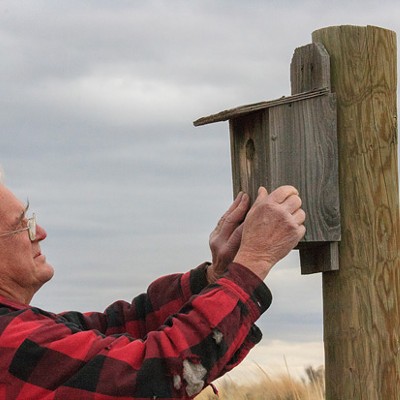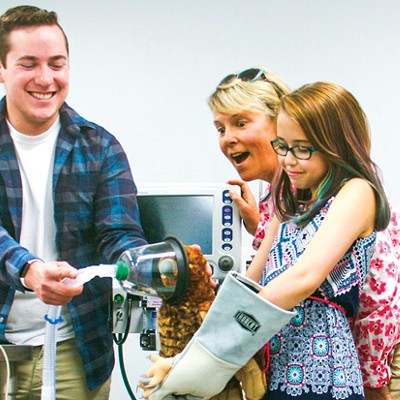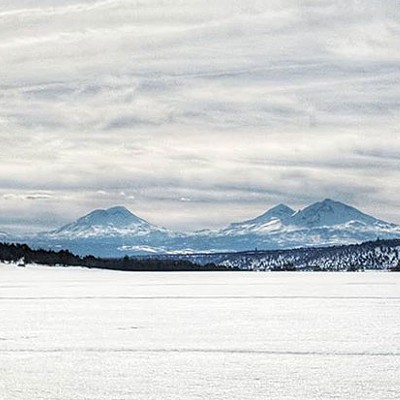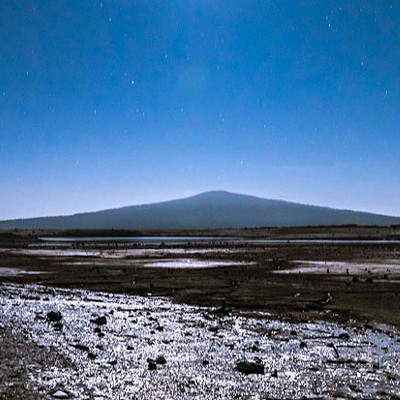The recent big snows that have hit us, also have brought quite a few phone calls from people asking about wildlife in winter. For those mule deer "pets" hanging around Sisters and Bend, it is tough going when the snow gets deep. They've lost all the benefits of kitchen and flower-garden left-overs buried deep under the snow; all that is sticking up are bare willow, ash, alder, bitterbrush and the lower branches of juniper and pine.
In the mid-1950s, the mule deer fawn survival was so high the deer ate themselves out of house and home throughout their winter range (literally). Anyone driving Hwy 31 from La Pine to Silver Lake could not help but notice the browse line under the trees going deep into both Crescent and Ft. Rock District forests along Hwy. 31.
(To solve the over-population problems, ODFW—in those days, the Oregon Game commission—opened an any-sex, age deer-hunting season in the fall to kill off the surplus.)
Probably the biggest problem during deep snow is the inability of pregnant does to get to the rich, high protein plants buried out on the deer winter range. Tiny, green forbes under the snow are sleeping away, waiting for the warmth of spring, and that's when the mule deer does really go after them. Those tiny plants are, literally, the life-blood of the unborn fawns. This is when bitterbrush really saves a lot of deer from starvation.
But while the above-snow browsers are having a tough time, voles—a small, thumb-sized, short-tailed rodent—couldn't ask for anything better. They build tunnels under the snow and munch their way though every green thing they bump into, safe from predators. Well almost...
Weasels are built to pursue small rodents down burrows and under the snow. You should be as lucky as Kody Osborne, Sunriver naturalist. He was recently snowshoeing in a meadow, when suddenly, a Short-tailed Weasel popped to the surface right in front of him. Kody stood motionless, amazed at his good fortune (which was the polite thing to do as well), and was rewarded for his patience when, after dropping out-of-sight, and not sensing any movement, the weasel popped up again to stare Kody down.
Now, if Kody had been a Rough-Legged Hawk or Great Horned Owl, it would have been curtains for that curious weasel. In some wonderful way, the Rough-Legged Hawk, Buteo lagons—which is down in this neck-of-the-woods from its nesting territories in the Far North—can hover over a blanket of snow, either watching for a tell-tale movement under the snow (or perhaps listening); then with unerring accuracy, drop into the snow like an Osprey after a fish, and come up with a vole or gopher.
And speaking of Osprey, the ones we see fishing our high lakes in summer are wintering in Mexico, Central America, and as far south as Costa Rica. While our little Screech Owl look-alike that nests around Lava Butte in summer—the Flammulated Owl—is spending its winter in Panama.
That is the beauty of having wings. Hummingbirds and warblers also take to wing and head south. But it isn't the temperature that tells them when it's time to leave; it is the length of day and how far the Sun is above horizon. (Our longest traveler is the Swainson Hawk, it spends winter in Chile and Argentina.)
There are several birds that don't heed that call to fly south. Chickadee are here year-round, along with many of our familiar backyard birds, such as house sparrows, flickers, white-headed woodpeckers and finches, along with the bird hawks that like to eat them.
(But those krijillions of robins eating juniper berries and pooping all over your cars are down from Canada and other northern climes.)
It may surprise you to know we have two butterflies in Central Oregon that wait out winter as adults. The beautiful Mourning Cloak can be seen on warm days in winter, fluttering about, pumping up the oxygen in their blood, and, if you're lucky, you may see an adult Tortoiseshell out in the warm sun. They spend the cold tucked in a hollow log, or deep in a woodpile, hibernating from the extremes of winter. Their blood (not anything like humans') has anti-freeze in it; the colder it gets, the better the anti-freeze.
The animal that I most admire in winter is the bat. Out in Wind Cave—yes THAT Wind Cave so many "poor sports" can't seem to accept being closed by Forest Service mandate—hundreds of Townsend's big-eared, and Myotis bats awe sleeping away winter, on the thin line between life and death.
They've spent the summer gobbling up mosquitoes, moths, beetles, and hundreds of other kinds of insects at night, slowly building up that life-giving fat reserve that will sustain them as the sleep through winter.
Lava caves are just the right environment for bats to spend winter, providing they're not molested and can sleep peacefully through the winter. The temperate is a steady 40-degrees in most lava caves, which is perfect for hibernating bats.
Unfortunately, there are those confounded "poor sports" who—for some reason I can not comprehend—have to kill things. That's why Wind Cave and others are closed. Back in the '70s, I was taking part in a bat-banding research study, and banded hundreds of bats coming to the lava caves south of Bend to spend winter.
In our well-known (and well-used) Boyd Cave, I banded Townsend Big-eared bats, one who came to spend winter 11 years in a row, almost to the same spot way in the back of the cave. On the 12th year I found it lying on the floor, dead; someone had shot it. It made me wonder how many years I might have met up with my little friend if he had lived—as one bat in another (un-named) cave, was found 21-years after it was banded, alive-and-well.
The next time you are out snowshoeing, skiing or snowboarding, watch for the snow scorpion (not an arachnid, but a fly). They're black, about the size of your little fingernail, and in late February you can observe the males skipping over the snow looking for females. Life and love goes on, no matter who, what, or where you are.


























